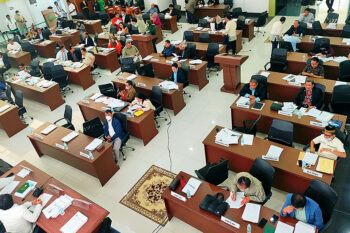
Film Review: Killers of the Flower Moon
Directed by: Martin Scorsese
Written by: Martin Scorsese and Eric Roth based on a book by David Grann
Cast: Leonardo DiCaprio, Lily Gladstone, Robert de Niro and many others
Currently showing nationwide in cinemas.
I rarely review Hollywood films as I would rather champion our own Pinoy movies, especially those of Mindanawon filmmakers. However, the plot of this remarkable film—that combines elements of the Western, crime and drama film genres as to constitute an epic of a film—echoes very similar narratives to what have happened to the Lumad or our indigenous peoples that it is worth helping to popularize it, so there can be more viewers of this film.
While the events narrated in this riveting film took place in the 1920s impacting on the life of the Osage Native Americans living in the Osage County in Oklahoma, USA, parallel events are taking place in parts of Mindanao today. The only difference are the mineral resources found in the indigenous territories, the characters who constitute the villains of the story, the manner of the killings and the role of the law enforcers.
By the end of this film, justice was finally served as the culprits all ended up in jail and the killings temporarily ended. However, in the case of the injustices committed against our own Lumad communities, the eventuality that justice can be served is as impossible to attain as the ability of our State apparatus to end corruption and the reign of impunity. The other reality is that the agency tasked to protect the interests of our Lumad communities—the National Commission on Indigenous People (NCIP)—has been inutile in fulfilling its mandate.
To watch Killers, one has be patient to sit through more than three hours. Scorsese had no choice for there are many angles of the narrative that need to be seen on screen. There is the historical backdrop of how the white European-descended Americans occupied Native American territories, the discovery of oil (Oklahoma’s black gold), the change in the people’s lifestyle as they accumulated wealth, the tragic murders committed against the Osage nation, how the local powers-that-be were in collusion to stop any investigation of the murders and lastly—the driving force of the film—the marriage between a white American veteran and the Osage heiress of oil fortune. All of these were based on true events historically documented which David Grann incorporated into his novel.
Perhaps the producers should have considered doing a teleserye with at least a dozen episodes! However, this is a kind of film that should be seen on the wide screen inside a cinema. If viewed only with the computer or TV screen, it loses a lot of the power of the story-telling. Scorsese moves from presenting a wide screen view of the beauty of the landscape to intimate bedroom scenes. The film is book-ended with the meaningful rituals of the Osage nation, presented with deep respect and made possible by the filmmakers entering into a collaboration with the Osage elders.
The first one is a somber scene where the elders bury a ceremonial pipe, manifesting how they mourned the assimilation of their descendants into white American society. In a number of scenes, the elders lamented how they had earlier moved from another location and relocated to Oklahoma only to be pushed out again from their ancestral land. And that in the process they lost their warrior tradition and felt helpless to resist those who oppressed them. At the end of the film, there is a community ritual where through chanting and dancing, the Osage people celebrated the end of the killings. This is of course just a temporary respite, because we know that until today, the native Americans in the US continue to face discrimination from the white majority.
This film, produced at a whopping budget of USD 200 million, can only be described as having a series of sumptuous scenes. A whole town was built as a set for the film production right in a location in Oklahoma where a train would bring new migrants seeking jobs. A scene showing the arrival of all these migrants gave the film its majestic swept further heightened by the scene of the hundreds of oil towers arising out of the landscape. There are scenes of parades, a car chase, street dancing and so many other eye-popping scenes but which stay on the screen only a matter of minutes. Special attention given by the cinematographer is the burning of the ranch of Kale showing metaphorically the burning of the entire Osage nation.
A focus of the film is the mistreatment of the aboriginal people in what became the U.S.A. as viewed from the lens of one family among the Osage nation. This was the family of Mollie Kyle (played by Lily Gladstone) who owned the richest plot where oil was found. A wealthy rancher, William K. Hale (played by the outstanding actor Robert de Niro playing a villainous role), schemed to cash in on the Kyle’s oil headrights and life insurance policies.
Thus, he planned to find a way to eliminate all the members of Mollie’s family through various ways from poisoning to shooting them dead to dynamiting their homes. His plan to take over the Kyle family’s wealth was to have his nephew, Ernest Burkhart (a role that could bring another Oscar to Leonardo diCaprio), get married to Mollie. Eventually Hale and Ernest also schemed to kill Mollie by poisoning her, so that all the money then goes to Ernest and eventually to Hale. Suspecting foul play, Mollie found her way to Washington, D.C. to seek help to investigate the murders and eventually a group of FBI agents arrived in the scene to look into the crimes.
There are various scenes that help the viewer understand the repercussions of the white people’s colonization of the native Americans’ lands. Alienated from their land and culture, many of them were drawn to drinking and with the availability of moonshine, they began to be labelled by the whites as drunkards, a label that has persisted until today. There are repercussions in the intermarriages between white males and Osage women, including husbands killing their wives to secure their wealth. The gun culture of the Americans—typical of a Western film—is clearly profiled which has persisted until today resulting in the shooting of pupils in schools.
This film has been positively reviewed as a masterpiece by some film critics. A profile of Scorsese recently appeared in Time magazine, to pay homage to this great filmmaker as his recent film was released. Indeed, there has been no dearth in the favorable reviews that have appeared in media since the film was first shown in the Cannes festival and especially after its release. All aspects of the film—from the acting to the cinematography to the music—shows Scorsese at his best (not surprising for a director with a string of Oscar-nominated films, including Raging Bull, Mean Streets, Taxi Driver and Goodfellas).
But more than the pleasure of watching a truly excellent, engaging film—which serves as an antidote to all the Marvel films which unfortunately are the current blockbusters—watch Killers to understand the historical connection between how the white Americans treated indigenous peoples like the Osage nation and how the American colonizers in the country dealt with our own katutubo/Lumad.
When the Americans illegally took over the control of the archipelago (its only basis of occupation was the 1896 Treaty of Paris), continuing the Spanish colonial agenda, they did not recognize the rights of the Moro and the Lumad to their ancestral domain. The 1935 Constitution passed during the American regime recognized only private (with land titles) and public lands which belonged to the State. Henceforth the IP peoples remained powerless in securing titles of their ancestral land. This was supposed to change in 1997 with the passage of the Indigenous Peoples Rights Act. However, this law has not led to the emancipation of the IPs because of the loopholes in the law and the incapacity of the NCIP to fully live up to its mandate.
Meanwhile, the Americans allowed the entry of American corporations to take over vast tracts of land (at least 1,024 hectares) to set up plantations in many areas in Mindanao leading to the presence of plantations engaged in agri-business. And until today these plantations continue to expand further pushing Lumad communities out of their ancestral land. And they also encouraged mining companies to begin explorations leading to the setting up of the mining industry in this country. With the passage of the 1995 Mining Law, there has been no end to the aggressive drive of mining firms to take over vast tracts of land from Zamboanga to Cotabato to Surigao.
Where greedy corporate firms decide to take over vast of lands—by hook or by crook and unfortunately there are many crooks in government just willing to assist them—the eruption of violence follows. First there are harassments to push the IPs out of their lands. As they resist to protect their land rights, reports after reports indicate many of their leaders arrested, shackled in prisons and eventually summarily killed. Until today, the killings have persisted.
And we all know who are the actual killers, namely, the corporate firms’ armed guards, the abusive military and their para-military troops (including some IP leaders who have been won over through various means to support the military’s anti-insurgency campaigns in Lumad territories). But we also know who are ultimately the ones who order these killings, namely, those corporate honchos in Makati and their foreign counterparts! As shown in Killers, greed can be such an all-consuming drive for the rich that they have no qualms murdering those who stand in their way!
Who among our filmmakers—attention Joel Lamangan, Brillante Mendoza, Lav Diaz, Sheron Dayoc, Arnel Mardoquio, et al. —might make a film parallel to what Scorsese did with Killers? Who among our producers are willing to bankroll such a film with the possibility that everyone involved in the film could be red-tagged? And is there an audience for such a film when our movie audience prefer the slapstick films of Vice Ganda, the action films of Coco Martin and the teen-age flicks of our rising stars?
At least for now, we can be thankful that there is a Hollywood film that can mirror our own tragic history of how the Lumads have been treated for centuries already. One can only hope more Filipinos can watch this film and make a direct connection to the reality faced by our own indigenous people today. The month of October is supposed to be the month when we pay close attention to the situation of the IPs and find ways how we can be in solidarity with them to fight for their human and land rights!
In a statement released by the Episcopal Commission for Indigenous Peoples (ECIP) in observance of the 46th Indigenous People’s Sunday on October 8, the commission emphasized several critical issues and concerns related to IPs in the Philippines, and advocates for the recognition of indigenous communities’ rights to their ancestral lands and domains, considering it an essential aspect of their self-determination and cultural preservation.
In 1992, when Rigoberta Menchu Tum—a member of the K’iche’ tribe of Guatemala—received the Nobel Peace Prize, she spoke these words as part of her acceptance speech: “Our history is a living history, that has throbbed, withstood and survived many centuries of sacrifice. Now it comes forward again with strength. The seeds, dormant for such a long time, break out today with some uncertainty, although they germinate in a world that is at present characterized by confusion and uncertainty.”
Let us all take part in living out this history!
(MindaViews is the opinion section of MindaNews. Redemptorist Brother Karl Gaspar is Mindanao’s most prolific book author. Gaspar is also a Datu Bago 2018 awardee, the highest honor the Davao City government bestows on its constituents. He is presently based in Cebu City).






